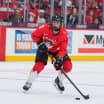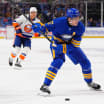If hockey truly is a game of inches, the 8 inches the NHL trimmed from the side of its nets are benefiting shooters in big moments during the 2016 Stanley Cup Playoffs.
When San Jose Sharks forward Patrick Marleau went behind the net and swept the puck in off the skate of Pittsburgh Penguins goaltender Matt Murray to tie Game 1 of the Stanley Cup Final on Monday, it was the 10th wraparound-style goal scored during the playoffs.
Wraparound goals increasing in playoffs
Reduction of net depth has led to more goals originating from behind goaltenders
By
Kevin Woodley
NHL.com Independent Correspondent
Many came at crucial times, including the series-clinching goal by John Tavares of the New York Islanders to eliminate the Florida Panthers in the second overtime of Game 6 in the Eastern Conference First Round.
Most would not be possible if the NHL had not reduced the footprint on the bottom of the nets prior to the 2013-14 season, making them 4 inches shallower and 8 inches narrower. The latter measurement, which reduced the radius around the sides of the net and knocked 4 inches off each side, makes it easier for forwards to turn the final corner and complete the wraparound by reducing how far they have to swing out before bringing the puck back in.
Sharks backup goalie James Reimer had a front-row seat for four San Jose goals involving wraparounds or in-tight walkouts that may not have been possible with the old nets.
"The net is a big part," Reimer said. "Bottom line is, wraps are quicker by a split second now."
San Jose forward Tomas Hertl scored in a Game 3 win against the St. Louis Blues in the Western Conference Final, and captain Joe Pavelski scored two big goals on plays that started behind the net. Pavelski's first was the winning goal early in the third period of Game 1 against the Los Angeles Kings in the first round, and his second opened the scoring and set the tone 3:57 into a series-clinching Game 6 win against St. Louis.
Not all were traditional wraparounds in terms of tucking the puck just inside the post.
Hertl's goal was more of a walkout from behind the net, though it's worth noting Joe Thornton may not have had enough room to thread a brilliant pass to him behind the net if not for the 4-inch reduction in the depth of the net. Pavelski's first was a wraparound, but he swung the puck all the way around wide to beat goalie Jonathan Quick on the far side. Pavelski's second goal, which caught Blues goalie Brian Elliott looking the other way on a play from behind the net, was a perfect example of the impact of the new nets. Pavelski brought the puck out directly along the edge of the net on his backhand before tucking it in just before Elliott recovered to the post.
"I don't think guys are wrapping more necessarily, because there are only certain circumstances you can do it," said New Jersey Devils goalie Cory Schneider, a student of the position who has done in-studio playoff analysis for NHL Network. "But it's definitely made it easier to get that last foot or two, which is all it takes to get there before the goalie does."
Murray has been victimized by that "last foot or two" a couple times in these playoffs, and backup Marc-Andre Fleury, in his only playoff start, was beaten on a wraparound for a late tying goal by Tampa Bay Lightning forward Nikita Kucherov in Game 5 of the Eastern Conference Final. On all three goals, the Penguins goaltender got caught outside the post facing an attacking player on the short side and was unable to get back to the other side in time.
For goalies, it's not so much the extra couple of feet they have to recover when they get caught on their knees outside their posts, it's the amount of rotation required to turn their body all the way around before pushing back to that far post that causes the biggest delay getting across.
"It takes too long to pivot and then push," Reimer said, noting a "desperate" headfirst dive can sometimes be faster. "It's a ridiculously hard play to come back around once you are caught."
It's especially tough on rush chances and plays where the attacking player is coming with speed off the rush. That's how Washington Capitals forward T.J. Oshie beat Murray for the overtime winner in Game 1 of the second round, drawing the rookie goalie to his knees outside the post with the threat of a shot on the short side before wrapping it around the other end.
Similar plays that resulted in rebounds onto the stick of an attacking forward coming at the net with speed also led to the Kucherov winner on Fleury and the series-clinching double-overtime goal by Tavares, who cut tightly around the far side before tucking it in.
As good as goalies have become at moving in and off their posts with a variety of techniques, which decreases the likelihood of getting caught on plays that start behind the net, it can be hard to rotate and recover across in time when they get caught outside their posts.
"It's way more likely on a rush with speed, fake shot or quick rebound," Schneider said.

















